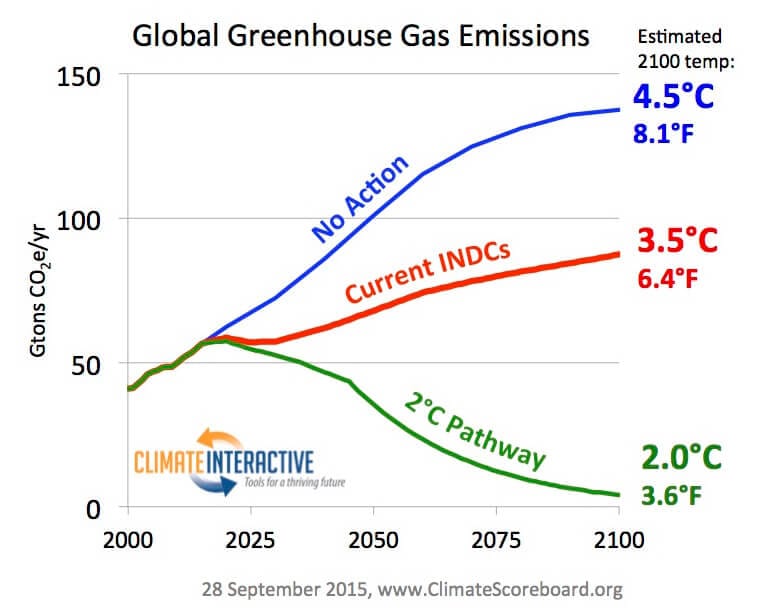Here’s the bad news: The sum total of the climate pledges made by countries in the lead-up to the Paris climate change summit fall well short of the 2°C target. In fact, they are only likely to reduce global warming from the “do nothing” trajectory of 4.5°C by 2100 to the “doing something” trajectory of 3.5°C. The world will need to at least double its efforts to avoid the worst impacts of climate change.
Here’s the good news: That result is pretty much as expected. There was no real hope that Paris would “save the planet” and deliver the 2°C outcome everyone knows is the bare minimum to contain the runaway impacts of climate change. But it should provide a framework to achieve that goal, and these pledges will buy the world some time – about 7 years.
That is the estimate from the Massachusetts Institute of Technology’s Sloan School of Business and research group Climate Interactive, who have tallied up the pledges – known as Intended Nationally Determined Contributions (INDCs) – made so far for the Paris climate talks.
“We’ve made progress, and our analysis shows that with further action following the Paris negotiations we can keep warming below 2°C,” said Andrew Jones, of Climate Interactive. “The current barriers are political and social and, we believe, can be overcome.”
Every major country – and dozens of smaller ones – have made their pledges by the October 1 deadline. India, one of the four largest polluters, will deliver its pledge on October 2, Mahatma Gandhi day.
The pledges are for targets for 2025 or 2030, and in some cases for both. They range from the EU’s pledge to cut emissions by 40 per cent on 1990 levels by 2030, China’s pledge to cap emissions by 2030, to the US commitment for a 26-28 per cent cut on 2005 levels by 2025, and Australia’s 26-28 per cent cut on 2005 levels by 2030. Brazil has announced a 43 per cent cut by 2030, while Indonesia has pledged to stabilise emissions.
But those pledges, while welcome, are still well short of what needs to be achieved. Jones told Climate Progress that the pledges “buy” around 7 years for countries to ramp up their targets.
And here is what the world needs to achieve. The red line (the current pledges) stay close enough to the green till shortly after 2020, but then need to be ramped up significantly to meet the green pathway.
Experts say ramping up those targets should be easier than many governments admit.
“We need stronger efforts to reduce emissions, but the good news is that the costs of emissions reductions through efficiency and clean renewable energy are falling fast,” said Dr John Sterman of MIT Sloan. “Nations that adopt policies to cut their emissions will speed the innovation we need and position themselves to prosper in the decades to come.”
Indeed, the Australian government’s own modelling into various emissions reduction targets showed very little cost difference between its current policy and a 45 per cent reduction target by 2030, which the Climate Change Authority has insisted Australia needs to achieve to meet its fair share of the 2°C target.
The likely process to be agreed on in Paris will mean that targets will be reviewed in future years. Environment minister Greg Hunt says that Australia could lift its targets in 2020 and/or 2025, depending on the result of reviews that could be held in 2017/18.
For the moment, however, he is insisting that Australia has gone as far as it can, and has imposed a “difficult and challenging” target; although most independent analysis suggests Australia could go much further, and is trailing at the bottom edge of pledges made by developed countries. Climate Action Tracker rates Australia as “inadequate”, and has a great little interactive chart that you can play with here.
Hunt insists that Australia has the highest per capita reduction targets in the G20. But that is only because Australia has done virtually nothing in emissions reductions in the past 20 years, and is taking its base year as 2005, which had much higher emissions than previous baselines such as 1990 and 2000. According to most estimates, Australia will still have easily the largest emissions per capita of any developed country.












